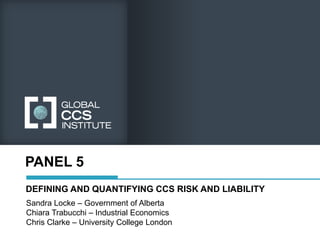
Global CCS Institute - Day 2 - Panel 5 - Defining and Quantifying CCS Risk and Liability
- 1. PANEL 5 DEFINING AND QUANTIFYING CCS RISK AND LIABILITY Sandra Locke – Government of Alberta Chiara Trabucchi – Industrial Economics Chris Clarke – University College London
- 2. LONG TERM LIABILITY RISK: THE PUBLIC POLICY DIMENSION (GCCSI International Members’ Meeting Calgary, 10-11 October 2012) CHRIS CLARKE Visiting Fellow, Carbon Capture Legal Programme, Faculty of Laws University College London Centre for Law and the Environment, Bentham House Endsleigh Gardens London WC1H 0EG Tel: +44 (0)20-8348 5589 (Dir); +44 (0)20-7679 1504 (Centre) email: chris.clarke@ucl.ac.uk www.ucl.ac.uk/cclp
- 3. Multiple liability regimes • first tier: – CCS laws & regulations • site selection/construction, operation, post-injection care • remedial action in cases of leakage or significant irregularity • financial security + financial contribution • specified obligations under associated laws – emissions allowances/credits – wider clean-up duties • second tier: – liability/clean-up rules under other laws • contaminated land, water pollution, waste, nature conservation – civil/common law liability • personal injury, property damage + some economic loss
- 4. Transfer of responsibility • a major concession, but not unlimited • transfer conditions & tests – closure/removal/reclamation + financial contribution – permanent containment, absence of leaks, trend towards stability • limits to transfer – covers all obligations under CCS & associated laws, but – liability continues under other regimes unless expressly specified • fault clause & grounds for re-opening – ambiguous standards (negligence, deficient data, etc) – in extremis? • unresolved issues/incomplete remediation
- 5. Moving goalposts • with long timescales, the rules will change – standards in 2040, 2050 or 2070 will not be the same as today – those standards will determine future obligations, eg: • how much remediation operator has to do • how stringent the transfer conditions are – development risk + regulatory risk • government commitments have a limited life – legal rules an important constraint, but not absolute in long run – science changes, political mood changes ⇒ govts have to react • liability burden also about (future) public policy • need strategy & mechanisms to manage that risk – promote excellence, maximise self-regulation, protect goodwill
- 6. Three key factors • performance – less damage ⇒ less liability (!) – confirmation that CCS works • the technical safety case is correct, the risks are minimal – not just operator’s own site(s) - also CCS worldwide • reputation – a valued contribution to climate change mitigation/env goals – despite changes in scientific understanding – public confidence, despite changing political priorities • harm – scale/seriousness if it occurs: manageable mishaps v major events – effectiveness of detection & response action – never underestimate the consequences of a serious event
- 7. Insurance/financial security • perfectly sensible idea, if implemented reasonably – protect the environment & the taxpayer/ensure obligations are met • policy muddle (in some jurisdictions?) – needs to be taken more seriously at legislative/policy stage – history of regulatory failures & problems • potential roadblock to CCS deployment • need to be clear about: – the purpose: what is it for? what is it supposed to achieve? – the amount: how much security is needed? how is that calculated? – capacity: how much is possible, by various means? – technical & legal constraints: financial services law, insolvency, etc • not a panacea or a magic wand
- 8. Financial security: suggestions • helpful to make three distinctions: – technical v. political issues – unavoidable obligations v. contingent liability risks – risk transfer v. non-risk transfer products • the amount is fundamental – very large amounts may require radical/collective solutions • some discounting for probability is inevitable • all options should be on the table – individual provision, phasing, pooling mechanisms, financial tests – different solutions for different jurisdictions • emissions allowance risk a special problem • financial services expertise is essential
